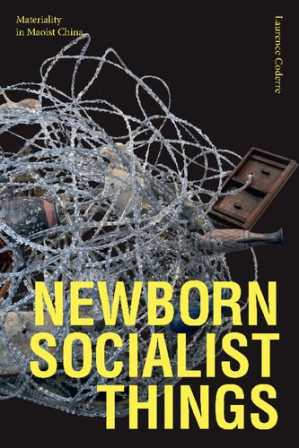English [en], .pdf, 🚀/lgli/lgrs/nexusstc/zlib, 17.9MB, 📘 Book (non-fiction), nexusstc/Newborn Socialist Things: Materiality in Maoist China/4904eefc071fc095955b7c74923b8311.pdf
Newborn Socialist Things : Materiality in Maoist China 🔍
Duke University Press Books, Duke University Press, Durham, 2021
Laurence Coderre, 1984- 🔍
description
Contemporary China is seen as a place of widespread commodification and consumerism, while the preceeding Maoist Cultural Revolution is typically understood as a time when goods were scarce and the state criticized what little consumption was possible. Indeed, with the exception of the likeness and words of Mao Zedong, both the media and material culture of the Cultural Revolution are often characterized as a void out of which the postsocialist world of commodity consumption miraculously sprang fully formed. In Newborn Socialist Things, Laurence Coderre explores the material culture of the Cultural Revolution to show how it paved the way for commodification in contemporary China. Examining objects ranging from retail counters and porcelain statuettes to textbooks and vanity mirrors, she shows how the project of building socialism in China has always been intimately bound up with consumption. By focusing on these objects—or “newborn socialist things”—along with the Cultural Revolution’s media environment, discourses of materiality, and political economy, Coderre reconfigures understandings of the origins of present-day China.
Alternative filename
lgrsnf/Newborn Socialist Things - Laurence Coderre.pdf
Alternative edition
United States, United States of America
Alternative edition
Durham ; London, 2021
Alternative edition
1, 20210628
Alternative edition
PT, 2021
metadata comments
lg3090000
metadata comments
{"isbns":["1478013397","1478021616","9781478013396","9781478021612"],"last_page":264,"publisher":"Duke University Press"}
Alternative description
"The Chinese Cultural Revolution (1966-76) is typically cast as a time of ubiquitous politics and scarce goods. Indeed, with the exception of the likeness and words of Mao Zedong, the media and material culture of the Cultural Revolution are often characterized as a void out of which the postsocialist world of commodity consumption miraculously sprang fully formed. In Newborn Socialist Things Laurence Coderre argues that the Cultural Revolution media environment and the ways in which its constituent elements engaged with contemporaneous discourses of materiality and political economy anticipated the widespread commodification now so closely associated with the Reform Period (1978-present)"-- Provided by publisher.
Alternative description
"The Chinese Cultural Revolution (1966-76) is typically cast as a time of ubiquitous politics and scarce goods. Indeed, with the exception of the likeness and words of Mao Zedong, the media and material culture of the Cultural Revolution are often characterized as a void out of which the postsocialist world of commodity consumption miraculously sprang fully formed. In Newborn Socialist Things Laurence Coderre argues that the Cultural Revolution media environment and the ways in which its constituent elements engaged with contemporaneous discourses of materiality and political economy anticipated the widespread commodification now so closely associated with the Reform Period (1978-present)"--Publisher's description
Alternative description
Cover
Contents
Acknowledgments
Introduction
Chapter 1. The Sonic Imaginary
Chapter 2. Selling Revolution
Chapter 3. Productivist Display
Chapter 4. Illuminating the Commodity Fetish
Chapter 5. Remediating the Hero
Chapter 6. The Model in the Mirror
Coda
Notes
Bibliography
Index
A
B
C
D
E
F
G
H
I
J
K
L
M
N
O
P
R
S
T
U
W
X
Y
Z
Contents
Acknowledgments
Introduction
Chapter 1. The Sonic Imaginary
Chapter 2. Selling Revolution
Chapter 3. Productivist Display
Chapter 4. Illuminating the Commodity Fetish
Chapter 5. Remediating the Hero
Chapter 6. The Model in the Mirror
Coda
Notes
Bibliography
Index
A
B
C
D
E
F
G
H
I
J
K
L
M
N
O
P
R
S
T
U
W
X
Y
Z
date open sourced
2021-08-16
🚀 Fast downloads
Become a member to support the long-term preservation of books, papers, and more. To show our gratitude for your support, you get fast downloads. ❤️
- Option #1: Fast Partner Server #1 (recommended) (open in viewer) (no redirect) (short filename) (no browser verification or waitlists)
- Option #2: Fast Partner Server #2 (open in viewer) (no redirect) (short filename)
- Option #3: Fast Partner Server #3 (open in viewer) (no redirect) (short filename)
- Option #4: Fast Partner Server #4 (open in viewer) (no redirect) (short filename)
- Option #5: Fast Partner Server #5 (open in viewer) (no redirect) (short filename)
🐢 Slow downloads
From trusted partners. More information in the FAQ. (might require browser verification — unlimited downloads!)
- Option #1: Slow Partner Server #1 (slightly faster but with waitlist)
- Option #2: Slow Partner Server #2 (slightly faster but with waitlist)
- Option #3: Slow Partner Server #3 (no waitlist, but can be very slow)
- After downloading: Open in our viewer
External downloads
All download options have the same file, and should be safe to use. That said, always be cautious when downloading files from the internet, especially from sites external to Anna’s Archive. For example, be sure to keep your devices updated.
-
For large files, we recommend using a download manager to prevent interruptions.
Recommended download managers: JDownloader -
You will need an ebook or PDF reader to open the file, depending on the file format.
Recommended ebook readers: Anna’s Archive online viewer, ReadEra, and Calibre -
Use online tools to convert between formats.
Recommended conversion tools: CloudConvert -
You can send both PDF and EPUB files to your Kindle or Kobo eReader.
Recommended tools: Amazon‘s “Send to Kindle” and djazz‘s “Send to Kobo/Kindle” -
Support authors and libraries
✍️ If you like this and can afford it, consider buying the original, or supporting the authors directly.
📚 If this is available at your local library, consider borrowing it for free there.
Total downloads:
A “file MD5” is a hash that gets computed from the file contents, and is reasonably unique based on that content. All shadow libraries that we have indexed on here primarily use MD5s to identify files.
A file might appear in multiple shadow libraries. For information about the various datasets that we have compiled, see the Datasets page.
For information about this particular file, check out its JSON file. Live/debug JSON version. Live/debug page.
